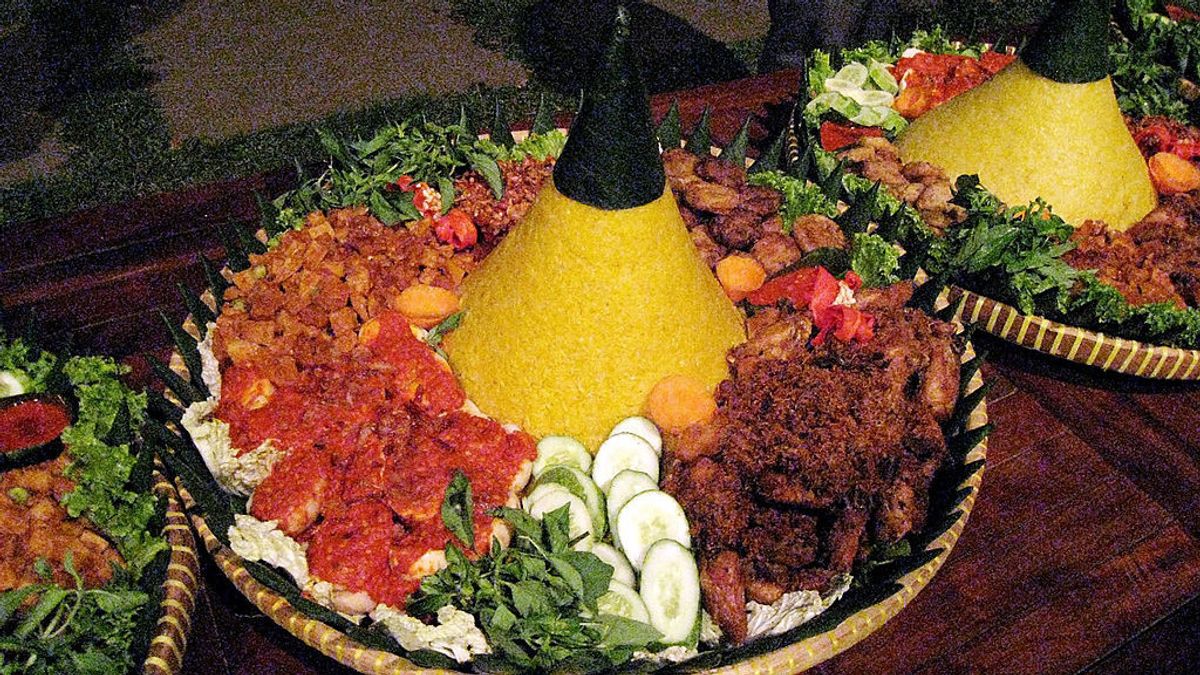JAKARTA - Tumpeng is the food of the Javanese people which is now well-known throughout Indonesia. The serving of tumpeng is usually rice shaped in a cone and arranged with the side dishes. According to the investigation, tumpeng has existed since the divine religion has not entered the archipelago. Uniquely, the changing times have made the value implied in tumpeng only shift, not change.
Etymologically, the term tumpeng is an abbreviation in the Javanese language, namely "tumapaking panguripan-tumaksi lempeng-tumuju pengeran" which means "life-walking straight-to God". The cone shape symbolizes that humans should live towards the path of God.
Meanwhile, terminologically, tumpeng is a type of traditional food that is almost always served during ritual offerings in Javanese tradition. That is one of the reasons why tumpeng has a sacred value that makes this food often served at important moments, such as the most common, namely when we have birthdays.
Origin of the tumpengUntil now, no one knows for sure when the first tumpeng was used as a food dish. However, M. Zein Ed-Dally in his writing entitled Tumpeng Food in Bancakan Tradition (2019) explained that tumpeng has been mentioned in the Ramayana literary manuscript, Arjuna Wijaya's literary manuscript, and Kidung Harsa Wijaya.
In the last two manuscripts, tumpeng is a food that is always served in every party celebration. This is also reinforced by Serat Centhini, who calls tumpeng synonymous with various kinds of eating events or bancakan.
According to the summary of the book, tumpeng has been around since before the entry of religion recognized by the government at this time entered the archipelago, especially Java and its surroundings. At that time the people still adhered to the Kapitayan belief.
As explained P.Mus in his book L'inde vue de L'Est. Cultes Indiens etindigenes au Champa, quoted by Mojok, explained that the Kapitayan adherents worship a god they call Sanghyang Taya, who is believed to have the nature of Tu or To, which consists of two characteristics, namely goodness and unkindness.
Tu is believed to be hidden in various objects that contain the word Tu such as watu (stone), tu-ngkub (sacred building), tu-nda (building with steps), tu-k (spring), tu-mbak (type of javelin), tu- nope (tree trunk) and others.
In its worship, offerings containing the word tu are also used, such as tu-mpeng, tu-mpi (cake made of flour), tu-ak (wine), tu-kung (a type of chicken), tu-mbu (flower holder) and others. Since this era, it is evident that tumpeng has been associated with food offerings.
Another proof that tumpeng has existed since the Kapitayan era is the existence of a spell that must be said before cooking tumpeng. It read: "Ni Towok, kulo intentions of Tumpeng." It means, "Ni Towok, I intend to cook Tumpeng."

Along with the entry of various influences of religious religiosity, be it Hinduism, Buddhism, and Islam, there have been many shifts in values previously believed by society. In the Hindu-Buddhist era, for example, a new tumpeng was made in the shape of a cone that resembled a mountain.
Tumpeng with the shape of a cone, said Zein, reflects the people of Hidnu who believe that Mount Mahameru is the place for the gods and their ancestral spirits to reside. So it is necessary to be purified and sacred, one of which is by serving food offerings that resemble Mount Mahameru.
Then when Islam entered and influenced the local culture of Javanese society, the meaning of tumpeng again shifted, but only limited to the spiritual aspect. Muslims no longer believe in objects that have supernatural powers as in the capitayan belief or in the gods as in Hindu-Buddhist beliefs, but are believed in Allah as the substance who created everything.
For Muslims, this shift in belief has implications, one of which is the text of a mantra or a modified prayer with the addition of praise to Allah and prayers to the Prophet Muhammad. Thus, it can be said that whenever an external influence appears, both from religious teachings and from cultural development, it will simultaneously shift - not erase - the values and principles previously understood and believed by society.
The English, Chinese, Japanese, Arabic, and French versions are automatically generated by the AI. So there may still be inaccuracies in translating, please always see Indonesian as our main language. (system supported by DigitalSiber.id)












